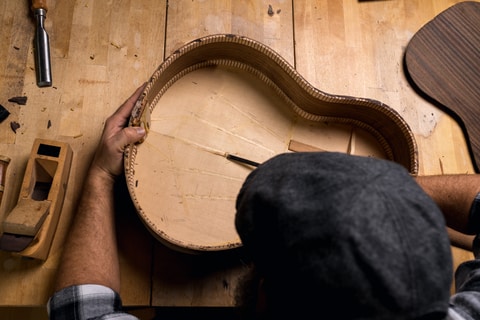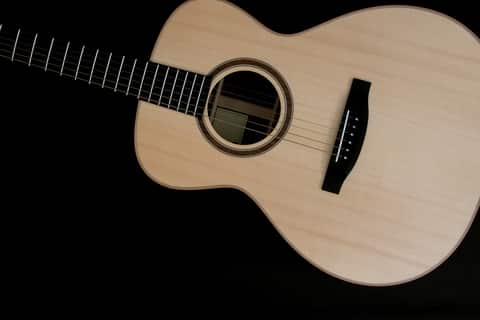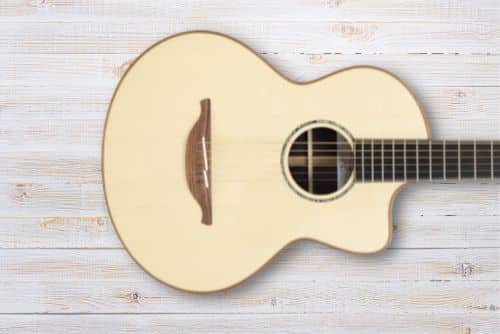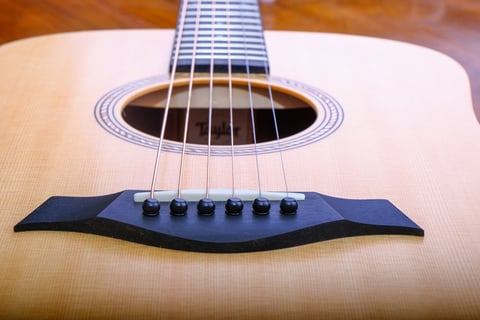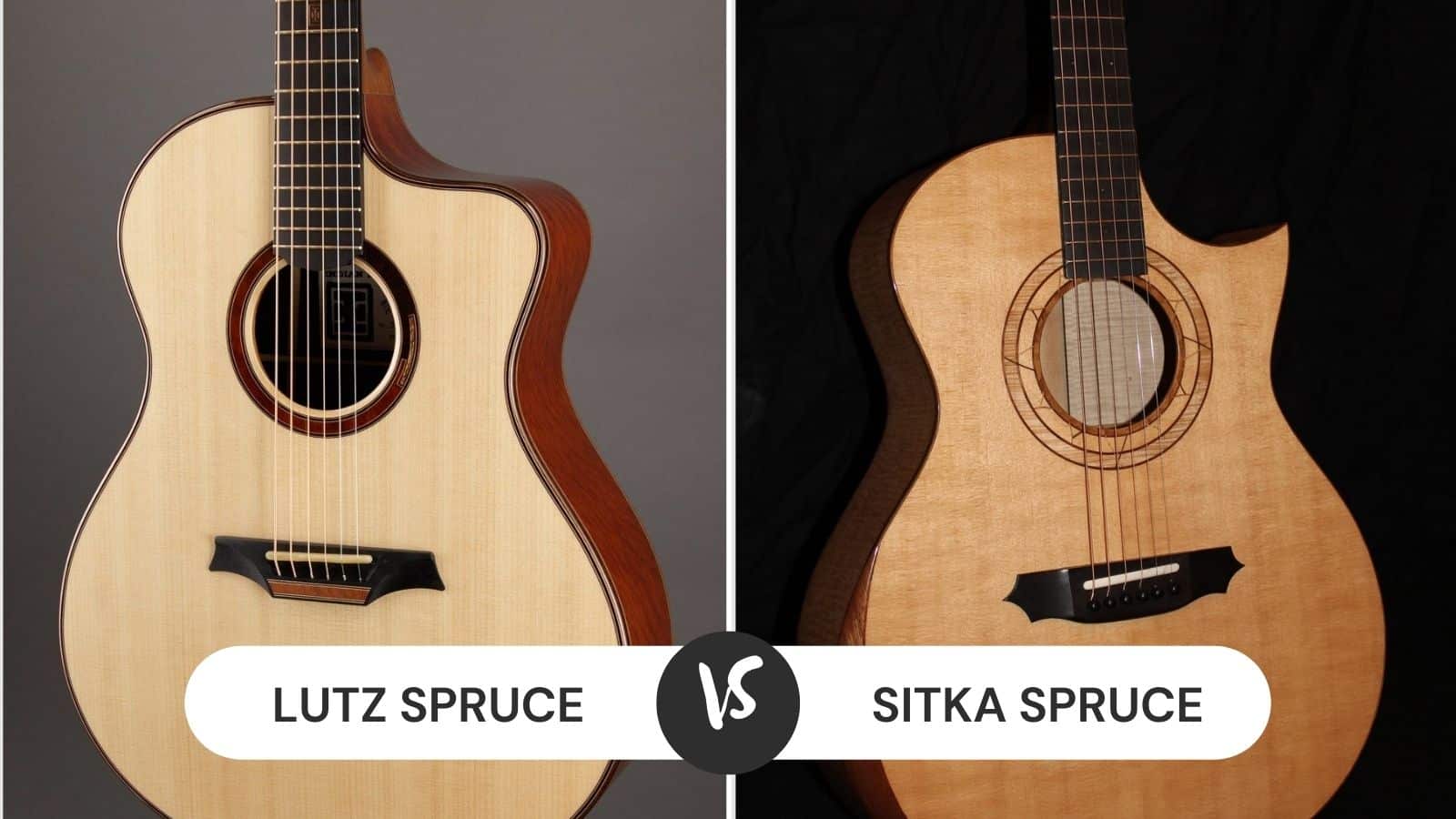
Picking the right guitar top is certainly hard as different tonewood produce different results- some are clearer than others, some produce better resonance, some have a more luxurious feel, and so on and so forth.
However, the general criteria are that the guitar top should be durable, have some elasticity in it, and should produce rich tones which can be lightened or deepened with tuners.
Another thing to keep in mind when looking for the best guitar based on tonewood is the design aesthetics- you don’t want a dark mahogany guitar for playing upbeat and light tunes.
While it may not seem important, the design on a guitar actually matters when it comes to blending in with the performance. The right guitar can inspire the creativity you need.
With all that being said, what tonewood should you go for? Well, most high-rated and popular guitars use either the Lutz spruce or the Sitka spruce.
Both these woods come from a tree of the genus Picea. These are evergreen trees found in low temperatures and their wood has the perfect amount of elasticity for being used as a guitar top.
While choosing either guitar top is a great idea as both are durable and efficient, there are some key differences between the Lutz spruce and Sitka spruce that affects the final sound produced by guitars using one of the two wood types.
If you’re looking to choose between these two guitars, it’s best to learn a little bit about them.
How Different Wood Affects Sound
| Features | Lutz Spruce | Sitka Spruce |
|---|---|---|
| Origin | It’s a combination found from naturally occurring hybrid trees of Sitka and white spruce. | It’s obtained from Sitka spruce trees. |
| Color | Usually lighter in color- creamy with a slight tan, may have pinkish hues. | A little darker in color- creamy white to yellow. Occasionally shows pink-red tones. |
| Overtone | Has stronger overtones. | Has weaker overtones. |
| Density | Denser and stiffer. More clarity. | Less dense, a little softer, more elastic. Light sound is created when fingerpicked. |
| Sound | Weaker fundamentals. | Stronger sound is produced from chords or fundamentals. |
Before we begin discussing the two most popular solid wood materials, it’s important to answer how different materials of guitar tops make a difference. Why does it matter if you go for Lutz spruce or Sitka spruce when they’re both wood from the same type of trees?
Well, the guitar top or the soundboard is finely engineered and made of either solid wood or lamination, fastened with good internal bracing.
Since the soundboard is quite thin (just about 2 to 3 mm thick), the material it’s made out of, whether it’s denser or less dense, solid or laminated, directly determines the sound quality of the instrument.
This happens because the vibration of the strings is transferred to the guitar top and each grain of the wood in the soundboard carries it, producing the music we hear.
Now if the wood is denser, the space between the grains is decreased, so the sound can’t move in it much. This grants you better clarity and music is delivered in quick jolts.
If the wood is less dense, you will find more space in it, and more music can travel around the grain. This gives you a higher resonance. This less-dense wood has dark resonance and more sustenance.
Both the Lutz spruce and Sitka spruce are pretty dense, but Lutz is slightly more compact. This means the music produced is lower on resonance and higher on clarity.
Another factor in choosing guitar tops is stiffness. Lutz spruce is much stiffer than other kinds of spruce. A stiffer guitar top means there are louder tap tones and the sound is bolder.
So this combination of stiffness and great density means the spruce gives you clear and loud melodies. It’s important to note that this is exclusive to flat tops- if there are bulges and domes, the softer woods will be better as they can accommodate the architecture.
That being said, it’s always wise to expect some inconsistencies. You won’t get exactly the same result from two different guitars using the same type of wood unless you’re buying a brand guitar that uses woods of similar ages.
Because wood is organic, it changes in shape and density over time. Older Sitka will be denser than younger Lutz because of the deeper grain.
Another common question guitar buyers ask is whether or not they should invest in solid wood- and the answer is yes.
Solid wood is more expensive than laminated (which uses multiple thin layers of spruce timber), but it’s stiffer and has greater density, making sure the sound, tone, volume, etc are all better.
If you strum the two guitars, you’ll notice a bold sound with a loud volume reverberating against you in the case of solid wood guitar tops.
The wood bracing on it also matters- wood bracing doesn’t just strengthen the top portion of the guitar and prevent it from collapsing from the tension and stress produced by guitar strings, but it affects the overall resonance.
As resonance is an important element of a guitar both live and in recording, it’s important to choose a solid bracing as well.
A Lutz Spruce vs Sitka Spruce Comparison
Lutz Spruce
Lutz spruce is a wood obtained from a hybrid of white and Sitka spruce. It grows in North America, typically in zones between the white spruce and Sitka spruce trees, making it more adaptable. The Sitka spruce provides it with durability while the white spruce improves the overall texture and feel.
When used in acoustic guitars, Lutz spruce not only improves the design but greatly enhances the performance. It creates great tones with moderate volume and adequate richness.
The Lutz spruce is wonderful for most playing styles and guitar players love the headroom and tonal output this unique wood provides.
As for the color, the Lutz spruce is light pink, pale, or creamy-white with a tan hue. You may find bands or darker stripes. The knots are small and the grain is very fine, giving you an even texture.
Note that if you’re building the guitar yourself, coloring this tonewood can be tricky due to pores. Find in-depth online tutorials for help.
Plus, this wood is great for eco-conscious people as spruce trees are in abundance and IUCN states them as the least concerning.
In short, the Lutz spruce combines the Sitka spruce’s strength and stiffness with the Engelmann or white spruce’s beauty and aesthetic.
This makes the Lutz clear, loud, and bright, perfect for playing all genres of music. The Lutz spruce is lively and carries better projection than most other tonewood types.
Sitka Spruce
Most guitars use the Sitka spruce for their soundboard- in fact, about 80% of all guitars produced use Sitka spruce. It’s also grown in abundance in North American forests, including in Canada and Alaska. The Sitka spruce as a tonewood is inexpensive yet ensures you have versatility when playing.
Sitka spruce is characterized by a tightly packed grain pattern and relatively high stiffness. Despite this, it’s quite lightweight and can produce good resonance.
Sitka spruce is responsive to fingerpicking too and can produce thin sounds when touched lightly. This spruce also gives unmatched richness in tones.
Because the wood can make both light sounds with fingerpicking and loud and aggressive playback when strummed, it’s considered the go-to for most musicians. Sitka wood was a personal favorite of Bob Marley,
The unique combination of strength and elasticity gives the Sitka spruce a dynamic and broad range of performance. You can do everything from fingerpicking the chords to aggressively strumming the guitar, yet receive crisp articulation.
Sitka spruce is very versatile and guitarists can play these in all styles and genres of music. This guitar top gives a contemporary look and can fit both modern and vintage guitar models.
All in all, if you’re looking for a guitar top material that’s affordable, good-looking, and durable with decent sound quality, you should go for Sitka spruce.

